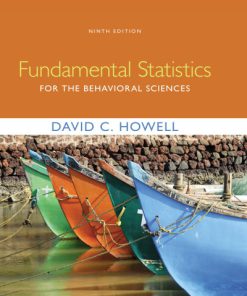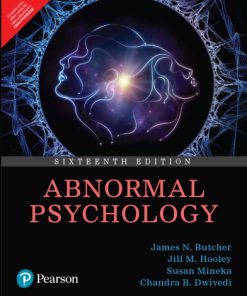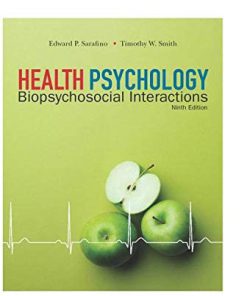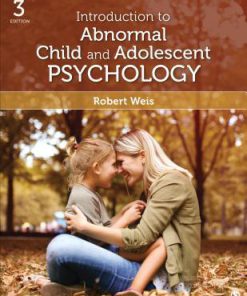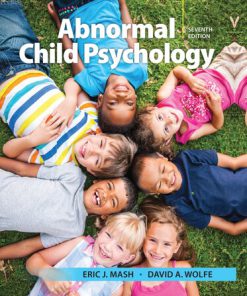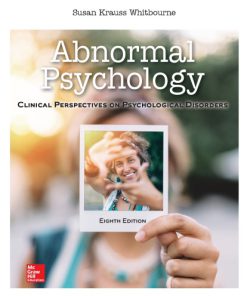Abnormal Psychology 9th Edition by Thomas Oltmanns, Robert Emery 9780134623870 0134623878
$50.00 Original price was: $50.00.$25.00Current price is: $25.00.
Abnormal Psychology 9th Edition by Thomas Oltmanns, Robert Emery – Ebook PDF Instant Download/Delivery: 9780134623870, 0134623878
Full dowload Abnormal Psychology 9th Edition after payment
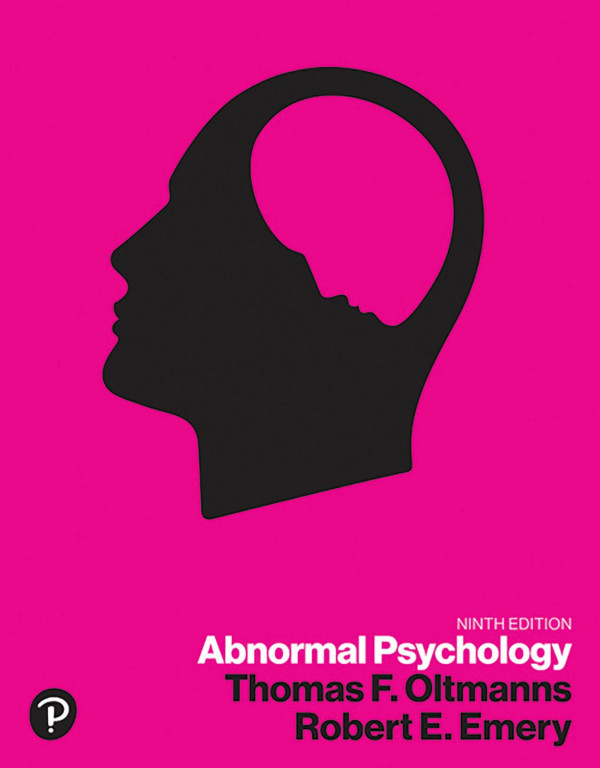
Product details:
• ISBN 10:0134623878
• ISBN 13:9780134623870
• Author:Thomas Oltmanns, Robert Emery
Abnormal Psychology
For courses in Abnormal Psychology An overview of abnormal psychology that focuses not on “them,” but on all of us Abnormal Psychology brings both the science and personal aspects of the discipline to life with a focus on evidence-based practice and emerging research. Authors Thomas Oltmanns and Robert Emery cover methods and treatment in context in order to helps readers understand the biological, psychological, and social perspectives on abnormal psychology. The 9th Edition has been updated to integrate coverage of the DSM-5, as well as the latest research and contemporary topics that will interest students.
Abnormal Psychology 9th Table of contents:
Chapter 1 Examples and Definitions of Abnormal Behavior
Learning Objectives
1.1: Recognizing the Presence of a Disorder
1.1.1: Features of Abnormal Behavior
1.1.2: Diagnosis and Definitions
1.2: Defining Abnormal Behavior
1.2.1: Harmful Dysfunction
The DSM-5
1.2.2: Mental Health Versus Absence of Disorder
1.2.3: Culture and Diagnostic Practice
1.3: Who Experiences Abnormal Behavior?
1.3.1: Frequency in and Impact on Community Populations
Lifetime Prevalence and Gender Differences
Comorbidity and Disease Burden
1.3.2: Cross-Cultural Comparisons
1.4: The Mental Health Professions
1.4.1: Common Mental Health Professions
1.4.2: The Future of Mental Health Professions
1.5: Psychopathology in Historical Context
1.5.1: The Greek Tradition in Medicine
1.5.2: The Creation of the Asylum
1.5.3: Worcester Lunatic Hospital
1.5.4: Lessons from the History of Psychopathology
1.6: Methods for the Scientific Study of Mental Disorders
1.6.1: The Uses and Limitations of Case Studies
1.6.2: Clinical Research Methods
Summary: Examples and Definitions of Abnormal Behavior
Key Terms
Chapter 2 Causes of Abnormal Behavior
Learning Objectives
2.1: Brief Historical Perspective
2.1.1: The Biological Paradigm
2.1.2: The Psychodynamic Paradigm
The Mind According to Psychoanalytic Theory
The Id
The Ego
The Superego
2.1.3: The Cognitive-Behavioral Paradigm
2.1.4: The Humanistic Paradigm
The Problem With Paradigms
2.2: Systems Theory
2.2.1: Holism
2.2.2: Causality
2.2.3: Developmental Psychopathology
2.3: Biological Factors
2.3.1: The Neuron and Neurotransmitters
2.3.2: Neurotransmitters and Psychopathology
Mind–Body Dualism
2.3.3: Major Brain Structures
2.3.4: Cerebral Hemispheres, Major Brain Structures, and Psychopathology
2.3.5: Psychophysiology
2.3.6: Behavior Genetics
Inheritance
Family Incidence Studies and Adoption Studies
Twin Studies
Shared Environment
Nonshared Environment
Genetics and Psychopathology
Genes AND Environment
Gene–Environment Interaction
Gene–Environment Correlation
Epigenetics
2.4: Psychological Factors
2.4.1: Human Nature
Evolutionary Psychology
Natural Selection
Sexual Selection
Attachment Theory and Dominance
attachment Theory
Dominance
2.4.2: Temperament and Emotions
Emotions
2.4.3: Learning and Cognition
Modeling
Cognitive Mechanism
2.4.4: The Sense of Self
Identity
Self-control
Self-Esteem
2.4.5: Stages of Development
2.5: Social Factors
2.5.1: Close Relationships
2.5.2: Gender and Gender Roles
2.5.3: Prejudice, Poverty, and Society
Summary: Causes of Abnormal Behavior
Key Terms
Chapter 3 Treatment of Psychological Disorders
Learning Objectives
3.1: Biological Treatments
3.1.1: Psychopharmacology
3.1.2: Electroconvulsive Therapy
3.1.3: Psychosurgery
3.2: Psychodynamic Psychotherapies
3.2.1: Freudian Psychoanalysis
Psychoanalytic Techniques
Insight
Interpretation
Timing
Therapeutic Neutrality
Transference
Countertransference
The Decline of Freudian Psychoanalysis
3.2.2: Ego Analysis
3.2.3: Psychodynamic Psychotherapy
3.3: Cognitive-Behavior Therapy
3.3.1: Systematic Desensitization
Other Exposure Therapies
Aversion Therapy
3.3.2: Contingency Management
3.3.3: Social Skills Training
3.3.4: Cognitive Techniques
3.3.5: Third-Wave CBT
3.4: Humanistic Therapies
3.4.1: Client-Centered Therapy
3.4.2: A Means, Not an End?
3.5: Research on Psychotherapy
3.5.1: Does Psychotherapy Work?
Improvement without Treatment
The Placebo Effect
The Allegiance Effect
Efficacy and Effectiveness
When Does Psychotherapy Work?
The Length of Treatment
The Client’s Background Characteristics
3.5.2: Psychotherapy Process Research
Common Factors in Psychotherapies
Differences
Similarities
Therapy as Social Support, Social Influence, and Pain Relief
Therapy as Social Influence
Pain Relief?
3.6: Couple, Family, and Group Therapy
3.6.1: Couple Therapy
3.6.2: Family Therapy
3.6.3: Group Therapy
3.6.4: Prevention
3.6.5: Specific Treatments for Specific Disorders
Summary: Treatment of Psychological Disorders
Key Terms
Chapter 4 Classification and Assessment of Abnormal Behavior
Learning Objectives
4.1: Basic Issues in Classification
4.1.1: Categories Versus Dimensions
4.1.2: From Description to Theory
4.2: Classifying Abnormal Behavior
4.2.1: The DSM-5 System
4.2.2: Culture and Classification
Ataques de Nervios
Symptoms
Causes
The Ambiguity of Culturally Defined Distress
4.3: Evaluating Classification Systems
4.3.1: Reliability
4.3.2: Validity
Forms of Validity
Etiological Validity
Concurrent Validity
Predictive Validity
4.3.3: Problems and Limitations of the DSM-5 System
4.4: Basic Issues in Assessment
4.4.1: Purposes of Clinical Assessment
4.4.2: Assumptions About Consistency of Behavior
4.4.3: Evaluating the Usefulness of Assessment Procedures
4.5: Psychological Assessment: Interviews and Observational Procedures
4.5.1: Interviews
Structured Interviews
Social Relationships
DSM Diagnostic Criterion:
Perception of Others
DSM Diagnostic Criterion:
DSM Diagnostic Criterion:
Advantages and Limitations of Interviews
Advantages
Limitations
4.5.2: Observational Procedures
Rating Scales
Behavioral Coding Systems
Advantages and Limitations of Observational Measures
Advantages
Limitations
4.6: Psychological Assessment: Personality Tests and Self-Report Inventories
4.6.1: Personality Inventories
Actuarial Interpretation
Advantages and Limitations of the MMPI-2
Advantages
Limitations
4.6.2: Projective Personality Tests
Recent Approaches to Projective Testing
Advantages and Limitations of Projective Tests
Advantages
Limitations
4.7: Biological Assessment Procedures
4.7.1: MRI and CT Scans
4.7.2: PET and fMRI Scans
Advantages and Limitations of Brain Imaging Techniques
Advantages
Limitations
Summary: Classification and Assessment of Abnormal Behavior
Key Terms
Chapter 5 Mood Disorders and Suicide
Learning Objectives
5.1: Symptoms Associated with Depression
5.1.1: Emotional Symptoms
5.1.2: Cognitive Symptoms
5.1.3: Somatic Symptoms
5.1.4: Behavioral Symptoms
5.1.5: Other Problems Commonly Associated with Depression
5.2: Diagnosis for Depression and Bipolar Disorders
5.2.1: Diagnosis for Depressive Disorders
Persistent Depressive Disorder
Premenstrual Dysphoric Disorder
5.2.2: Diagnosis for Bipolar Disorders
5.2.3: Further Descriptions and Subtypes
5.3: Course, Outcome, and Frequency
5.3.1: Depressive Disorders
5.3.2: Bipolar Disorders
5.3.3: Incidence and Prevalence
5.3.4: Risk for Mood Disorders Across the Life Span
5.3.5: Gender Differences
5.3.6: Cross-Cultural Differences
5.4: Causes: Social and Psychological Factors
5.4.1: Social Factors
The Relationship Between Stress and Depression
The Circumstances
Stress Generation
Gender Differences
Social Factors and Bipolar Disorders
Schedule-Disrupting and Goal-Attainment Events
Emotional Climate Within Families
5.4.2: Psychological Factors
Cognitive Vulnerability
Distortions
Maladaptive Schemas
Causal Attributions
Inhibition of Negative Thoughts
Integration of Cognitive and Social Factors
5.5: Causes: Biological Factors
5.5.1: Genetics
Twin Studies
Searching for Specific Genes
Genetic Risk and Sensitivity to Stress
5.5.2: The Neuroendocrine System
Brain Imaging Studies
Neurotransmitters
5.5.3: Integration of Social, Psychological, and Biological Factors
5.6: Treatment for Depressive Disorders
5.6.1: Depressive Disorders and Therapy
5.6.2: Antidepressant Medications
Selective Serotonin Reuptake Inhibitors
Tricyclics and Monoamine Oxidase Inhibitors
The Efficacy of Psychotherapy and Medication
5.7: Treatment for Bipolar and Mood Disorders
5.7.1: Lithium and Anticonvulsant Medications for Bipolar Disorder
5.7.2: Psychotherapy for Bipolar Disorder
5.7.3: Electroconvulsive Therapy for Mood Disorders
5.7.4: Light Therapy for Seasonal Mood Disorders
5.8: Suicide
5.8.1: Classification of Suicide
Nonsuicidal Self-Injury
Diagnostic Criteria
Causal Factors
5.8.2: Frequency of Suicide
5.8.3: Causes of Suicide
5.8.4: Treatment of Suicidal People
Crisis Centers and Hotlines
Summary: Mood Disorders and Suicide
Key Terms
Chapter 6 Anxiety Disorders and Obsessive–Compulsive Disorder
Learning Objectives
6.1: Symptoms of Anxiety Disorders
6.1.1: Anxiety
6.1.2: Excessive Worry
6.1.3: Panic Attacks
6.1.4: Phobias
6.2: Diagnosis of Anxiety Disorders
6.2.1: Specific Phobias
6.2.2: Social Anxiety Disorder (Social Phobia)
6.2.3: Agoraphobia
6.2.4: Generalized Anxiety Disorder
6.2.5: Course and Outcome
6.3: Frequency of Anxiety Disorders
6.3.1: Prevalence
6.3.2: Comorbidity
6.3.3: Gender Differences
6.3.4: Age Differences
6.3.5: Cross-Cultural Comparisons
6.4: Causes of Anxiety Disorders: Social and Biological Factors
6.4.1: Adaptive and Maladaptive Fears
6.4.2: Social Factors
Stressful Life Events
Childhood Adversity
Attachment Relationships and Separation Anxiety
6.4.3: Genetic Factors
6.4.4: Neurobiology
Social Context and the Amygdala
6.5: Causes of Anxiety Disorders: Psychological Factors
6.5.1: Learning Processes
Preparedness Model
6.5.2: Cognitive Factors
Perception of Control
Catastrophic Misinterpretation
Classical Conditioning
Attention to Threat and Biased Information Processing
6.6: Treatment of Anxiety Disorders
6.6.1: Psychoanalytic Psychotherapy
6.6.2: Systematic Desensitization and Exposure
6.6.3: Relaxation and Breathing Retraining
6.6.4: Cognitive Therapy
6.6.5: Antianxiety Medications
6.6.6: Antidepressant Medications
Long-Term Effectiveness of Anxiety Treatments
6.7: Obsessive–Compulsive and Related Disorders: Symptoms and Diagnosis
6.7.1: Symptoms of OCD
Obsessions
Compulsions
Cleaning
Checking
6.7.2: Diagnosis of OCD and Related Disorders
Hoarding
The Core Element
The Symptoms
Trichotillomania and Excoriation Disorder
Differentiating OCD from Other Disorders
6.8: Obsessive–Compulsive and Related Disorders: Frequency and Treatment
6.8.1: Course, Outcome, and Frequency of OCD
Frequency of OCD and Related Disorders
6.8.2: Causes of OCD
6.8.3: Treatment of OCD
Exposure and Response Prevention
Biological Treatments
Selective Serotonin Reuptake Inhibitors
Clomipramine
Summary: Anxiety Disorders and Obsessive–Compulsive Disorder
Key Terms
Chapter 7 Acute and Posttraumatic Stress Disorders, Dissociative Disorders, and Somatic Symptom Disorders
Learning Objectives
7.1: Acute and Posttraumatic Stress Disorders
7.1.1: Symptoms of ASD and PTSD
7.1.2: Diagnosis of ASD and PTSD
Posttraumatic Stress Disorder
Acute Stress Disorder
What Defines Trauma
Exposure to Disasters
Sexual Assault
Comorbidity
7.2: Frequency, Causes, and Treatment of PTSD and ASD
7.2.1: Frequency of Trauma, PTSD, and ASD
Course and Outcome
7.2.2: Causes of PTSD and ASD
Social Factors for PTSD
Biological Factors for PTSD
Does exposure to trauma have biological consequences as well as biological causes?
Does this mean that trauma damages the brain?
Psychological Factors for PTSD
Dissociation
The Value of Purpose
Emotional Processing
Meaning Making
Integration and Alternative Pathways
7.2.3: Prevention and Treatment of ASD and PTSD
Emergency Help for Trauma Victims
Treatment for Veterans
Treatment of ASD and PTSD
Cognitive Behavior Therapy for PTSD
Imagery Rehearsal Therapy
EMDR
Antidepressant Medication
7.3: Dissociative Disorders
7.3.1: Hysteria and the Unconscious
Charcot, Freud, and Janet
Hypnosis: Altered State or Social Role?
Psychological Science and the Unconscious
7.3.2: Symptoms of Dissociative Disorders
Trauma and Dissociative Symptoms
7.4: Diagnosis, Causes, and Treatment of Dissociative Disorders
7.4.1: Diagnosis of Dissociative Disorders
Depersonalization/Derealization Disorder
7.4.2: Frequency of Dissociative Disorders
Disorder or Role Enactment?
7.4.3: Causes of Dissociative Disorders
Psychological Factors for Dissociative Disorders
Biological and Social Factors for Dissociative Disorders
Social Factors
7.4.4: Treatment of Dissociative Disorders
7.5: Somatic Symptom Disorders
7.5.1: Symptoms of Somatic Symptom Disorders
Unnecessary Medical Treatment
7.5.2: Diagnosis of Somatic Symptom Disorders
Conversion Disorder
Somatic Symptom Disorder
Illness Anxiety Disorder
Body Dysmorphic Disorder
Malingering and Factitious Disorder
7.6: Frequency, Causes, and Treatment of Somatic Symptom Disorders
7.6.1: Frequency of Somatic Symptom Disorders
Gender, SES, and Culture
Additional Disorders With Somatic Symptom Disorders
7.6.2: Causes of Somatic Symptom Disorders
Biological Factors—The Perils of Diagnosis by Exclusion
Psychological Factors—Imagined or Real Trauma
Social Factors—The Influence of Culture
7.6.3: Treatment of Somatic Symptom Disorders
Summary: Acute and Posttraumatic Stress Disorders, Dissociative Disorders, and Somatic Symptom Disorders
Key Terms
Chapter 8 Stress and Physical Health
Learning Objectives
8.1: Defining Stress
8.1.1: Stress as a Life Event
8.1.2: Symptoms of Stress
Adrenal Hormones
8.1.3: Immune System Responses
Illness as a Cause of Stress
8.2: Coping and Resilience
8.2.1: Coping
8.2.2: Resilience
8.2.3: Health Behavior
Medical Advice
Illness Behavior
Social Support
8.3: Diagnosis of Stress and Physical Illness
8.3.1: Psychological Factors and Some Familiar Illnesses
8.3.2: Cancer
8.3.3: Acquired Immune Deficiency Syndrome (AIDS)
8.3.4: Pain Disorder
8.3.5: Sleep-Wake Disorders
8.4: Cardiovascular Disease and Stress
8.4.1: Biological and Psychological Factors of CHD
8.4.2: Social Factors of CVD
8.4.3: Integration and Alternative Pathways
8.4.4: Symptoms and Diagnosis of CVD
8.4.5: Prevention and Treatment of CVD
Summary: Stress and Physical Health
Key Terms
Chapter 9 Personality Disorders
Learning Objectives
9.1: Symptoms
9.1.1: Social Motivation
9.1.2: Cognitive Perspectives Regarding Self and Others
9.1.3: Temperament and Personality Traits
9.1.4: Context and Personality
9.2: Diagnosis
9.2.1: Cluster A: Paranoid, Schizoid, and Schizotypal Personality Disorders
9.2.2: Cluster B: Antisocial, Borderline, Histrionic, and Narcissistic Personality Disorders
Features of Borderline Personality Disorder
9.2.3: Cluster C: Avoidant, Dependent, and Obsessive–Compulsive Personality Disorders
9.3: A Dimensional Perspective on Personality Disorders
9.3.1: The Dimensional PD Model
9.3.2: Describing Personality Disorder in Terms of Traits
9.4: Frequency
9.4.1: Prevalence in Community and Clinical Samples
9.4.2: Gender Differences
9.4.3: Stability of Personality Disorders Over Time
9.4.4: Culture and Personality
9.5: Schizotypal Personality Disorder (SPD)
9.5.1: Symptoms of Schizotypal Personality Disorder
9.5.2: Causes of Schizotypal Personality Disorder
9.5.3: Treatment for Schizotypal Personality Disorder
9.6: Borderline Personality Disorder (BPD)
9.6.1: Symptoms of Borderline Personality Disorder
9.6.2: Causes of Borderline Personality Disorder
9.6.3: Treatment for Borderline Personality Disorder
Dialectical Behavior Study
9.7: Antisocial Personality Disorder (ASPD)
9.7.1: Symp toms of Antisocial Personality Disorder
Antisocial Behavior Over the Life Span
9.7.2: Causes of Antisocial Personality Disorder
Biological Factors
Social Factors
Range of Behavioral Skills
Results of Antisocial Behavior During Childhood and Adolescence
Psychological Factors
9.7.3: Treatment for Antisocial Personality Disorder
Summary: Personality Disorders
Key Terms
Chapter 10 Feeding and Eating Disorders
Learning Objectives
10.1: Symptoms of Anorexia
10.1.1: Significantly Low Weight
10.1.2: Fear of Gaining Weight
10.1.3: Disturbance in Experiencing Weight or Shape
10.1.4: Amenorrhea
10.1.5: Medical Complications
10.1.6: Struggle for Control
10.1.7: Comorbid Psychological Disorders
10.2: Symptoms of Bulimia
10.2.1: Binge Eating
10.2.2: Inappropriate Compensatory Behavior
10.2.3: Excessive Emphasis on Weight and Shape
10.2.4: Comorbid Psychological Disorders
10.2.5: Medical Complications
10.3: Diagnosis of Feeding and Eating Disorders
10.3.1: Diagnosis of Anorexia Nervosa
10.3.2: Diagnosis of Bulimia Nervosa
10.4: Frequency of Anorexia and Bulimia
10.4.1: Standards of Beauty and the Culture of Thinness
10.4.2: Age of Onset
10.5: Causes of Anorexia and Bulimia
10.5.1: Social Factors
Troubled Family Relationships
Enmeshed Families
Child Sexual Abuse
Parental Influence and Struggles with Their Own Diets
10.5.2: Psychological Factors
A Struggle for Perfection and Control
Depression, Low Self-Esteem, and Dysphoria
Low Self-Esteem
Dysphoria
Negative Body Image
Dietary Restraint
10.5.3: Biological Factors
10.5.4: Integration and Alternative Pathways
10.6: Treatments for Anorexia and Bulimia
10.6.1: Approaches to Treating Anorexia
Course and Outcome of Anorexia Nervosa
10.6.2: Approaches to Treating Bulimia
Course and Outcome of Bulimia Nervosa
10.6.3: Prevention of Eating Disorders
Summary: Feeding and Eating Disorders
Key Terms
Chapter 11 Substance-Related and Addictive Disorders
Learning Objectives
11.1: Symptoms of Addiction
11.1.1: Craving and Self-Control
11.1.2: Tolerance and Withdrawal
11.2: Alcohol, Tobacco, and Psychomotor Stimulants
11.2.1: Alcohol
Short-Term and Long-Term Effects of Alcohol
Disruption of Relationships
Blackouts
Interference With Job Performance
Problems With Legal Authorities
Health Problems
Severe Injuries and Premature Deaths
11.2.2: Tobacco
11.2.3: Amphetamine and Cocaine
11.3: The Impact of Other Drugs on Human Physiology and Behavior
11.3.1: Opiates
Short-Term Effects of Opiates
Long-Term Consequences of Opiates
11.3.2: Sedatives, Hypnotics, and Anxiolytics
11.3.3: Cannabis
11.3.4: Hallucinogens and Related Drugs
11.4: Diagnosis of Substance Use Disorders
11.4.1: Brief History of Legal and Illegal Substances
11.4.2: DSM-5
11.4.3: Course and Outcome
11.4.4: Other Disorders Commonly Associated With Addictions
11.5: Frequency of Substance Use Disorders
11.5.1: Prevalence of Alcohol Use Disorder
Gender Differences
11.5.2: Prevalence of Drug and Nicotine Use Disorders
11.5.3: Risk for Addiction Across the Life Span
11.6: Causes of Substance Addiction
11.6.1: Social Factors
11.6.2: Biological Factors
Genetics of Alcoholism
Twin Data
Adoption Data
Dopamine and Reward Pathways
Endogenous Opioid Peptides
11.6.3: Psychological Factors
11.6.4: Integrated Systems
11.7: Treatment for Substance Use Disorders
11.7.1: Detoxification
11.7.2: Self-Help Groups
The First Step
Working Through the Steps
Effectiveness
11.7.3: Cognitive Behavior Therapy
Coping Skills Training
Relapse Prevention
Short-Term Motivational Therapy
11.7.4: Two Major Studies
11.7.5: General Conclusions
11.8: Gambling Disorder
11.8.1: Symptoms of Gambling Disorder
11.8.2: Diagnosis of Gambling Disorder
11.8.3: Frequency of Gambling Disorder
Summary: Substance-Related and Addictive Disorders
Key Terms
Chapter 12 Sexual Dysfunctions, Paraphilic Disorders, and Gender Dysphoria
Learning Objectives
12.1: Normal and Abnormal
12.1.1: The Human Sexual Response Cycle
12.1.2: Disruptions in the Sexual Response Cycle
12.1.3: Historical Perspective
12.1.4: Evaluating the Quality of Sexual Relationships
12.1.5: Diagnosis of Sexual Dysfunctions
12.2: Sexual Dysfunctions
12.2.1: Male Hypoactive Sexual Desire Disorder
12.2.2: Erectile Disorder
12.2.3: Female Sexual Interest/Arousal Disorder
12.2.4: Female Orgasmic Disorder
12.2.5: Premature (Early) Ejaculation
12.2.6: Delayed Ejaculation
12.2.7: Genito-Pelvic Pain/Penetration Disorder
12.3: The Origins of Sexual Dysfunction
12.3.1: Frequency of Sexual Dysfunctions
12.3.2: The Impact of Age and Culture
12.3.3: Biological Factors Affecting Sexual Desire
12.3.4: Psychological Factors Affecting Sexual Desire
12.4: Treating Sexual Dysfunction
12.4.1: Psychological Treatments for Sexual Dysfunction
The Efficacy of Psychological Treatments
12.4.2: Biological Treatments for Sexual Dysfunction
12.5: Paraphilic Disorders
12.5.1: Symptoms of Paraphilic Disorders
12.5.2: Diagnosis of Paraphilic Disorders
12.5.3: Fetishistic and Transvestic Disorders
12.5.4: Sexual Masochism Disorder
Sexual Sadism Disorder
12.5.5: Exhibitionism, Voyeurism, and Frotteurism
12.5.6: Pedophilic Disorder
12.5.7: Rape and Sexual Assault
12.6: The Origins of Paraphilia
12.6.1: Frequency of Paraphilia
12.6.2: Biological Factors Causing Paraphilia
12.6.3: Social Factors Causing Paraphilia
12.6.4: Psychological Factors Causing Paraphilia
12.7: Treating Paraphilia
12.7.1: Aversion Therapy
12.7.2: Cognitive Behavioral Treatment
12.7.3: Hormones and Medication
Legal Issues
Community Notification Laws
Sexual Predator Laws
12.8: Gender Dysphoria
12.8.1: Symptoms of Gender Dysphoria
12.8.2: Frequency of Gender Dysphoria
12.8.3: Causes of Gender Dysphoria
12.8.4: Treatment for Gender Dysphoria
Summary: Sexual Dysfunctions, Paraphilic Disorders, and Gender Dysphoria
Key Terms
Chapter 13 Schizophrenia Spectrum and Other Psychotic Disorders
Learning Objectives
13.1: Symptoms of Schizophrenia
13.1.1: Positive Symptoms
First-Person Account of Delusional Beliefs
13.1.2: Negative Symptoms
13.1.3: Disorganization
Thinking Disturbances
Abnormal Motor Behavior
Catatonic Behavior
Stuporous Conditions
Inappropriate Affect
13.2: Diagnosis of Schizophrenia
13.2.1: DSM-5
13.2.2: Subtypes
13.2.3: Related Psychotic Disorders
13.2.4: Course and Outcome
13.3: Frequency of Schizophrenia
13.3.1: Gender Differences
13.3.2: Cross-Cultural Comparisons
13.4: Biological Causes of Schizophrenia
13.4.1: Genetics
Genetic Questions
Molecular Genetics
13.4.2: Pregnancy and Birth Complications
13.4.3: Neuropathology
Structural Brain Imaging
Functional Brain Imaging
General Conclusions
13.4.4: Neurochemistry
13.5: Social and Psychological Causes of Schizophrenia
13.5.1: Social Class
Migrant Studies
13.5.2: Expressed Emotion
High EE Outcomes
Understanding Family Attitudes
13.5.3: Interaction of Biological and Environmental Factors
13.6: The Search for Markers of Vulnerability
13.6.1: Designing a Measure for Vulnerability
13.6.2: Working-Memory Impairment
13.6.3: Eye-Tracking Dysfunction
13.7: Treatment of Schizophrenia
13.7.1: Antipsychotic Medication
Maintenance and Side Effects
Extrapyramidal Symptoms (EPS)
Tardive Dyskinesia (TD)
Second-Generation Antipsychotics
How Antipsychotics Function
13.7.2: Psychosocial Treatment
Summary: Schizophrenia Spectrum and Other Psychotic Disorders
Key Terms
Chapter 14 Neurocognitive Disorders
Learning Objectives
14.1: Symptoms of Neurocognitive Disorders
14.1.1: Delirium
14.1.2: Major Neurocognitive Disorder
Neurocognitive Symptoms
Memory and Learning
Verbal Communication and Perception
Abstract Thinking
Judgment and Social Behavior
Assessment of Neurocognitive Impairment
Neuropsychological Assessment
Personality and Emotion
Motor Behaviors
Dementia Versus Clinical Depression
14.2: Diagnosis of Neurocognitive Disorders
14.2.1: Brief Historical Perspective
14.2.2: Specific Types of Neurocognitive Disorder
Neurocognitive Disorder Due to Alzheimer’s Disease
Neurofibrillary Tangles
Amyloid Plaques
Frontotemporal Neurocognitive Disorder
Neurocognitive Disorder With Lewy Bodies
Vascular Neurocognitive Disorder
Neurocognitive Disorder Due to Traumatic Brain Injury
Huntington’s Disease
Parkinson’s Disease
14.3: Frequency of Delirium and Major Neurocognitive Disorders
14.3.1: Prevalence of Dementia
14.3.2: Prevalence by Subtypes of Neurocognitive Disorder
14.3.3: Cross-Cultural Comparisons
14.4: Causes of Neurocognitive Disorders
14.4.1: Causes of Delirium
14.4.2: Neurocognitive Disorder: Genetic Factors
Specific Genes
Amyloid Precursor Protein (APP Gene)
Presenilin Genes (PS1 and PS2)
APOE Gene
14.4.3: Neurotransmitters in NCD
14.4.4: Immunology and NCD
14.4.5: Environmental Factors
14.5: Treatment and Management
14.5.1: Medication
14.5.2: Environmental and Behavioral Management
14.5.3: Support for Caregivers
Summary: Neurocognitive Disorders
Key Terms
Chapter 15 Intellectual Disabilities and Autism Spectrum Disorders
Learning Objectives
15.1: Symptoms of Intellectual Disabilities
15.1.1: Measuring Intelligence
Controversies About Intelligence Tests
15.1.2: Measuring Adaptive Skills
15.1.3: Age of Onset
15.2: Diagnosis of Intellectual Disabilities
15.2.1: History of Diagnosis
15.2.2: Contemporary Diagnosis
Life and Death
15.2.3: Frequency of Intellectual Disabilities
15.3: Causes of Intellectual Disabilities
15.3.1: Biological Factors Leading to Intellectual Disabilities
Genetic Disorders
Fragile-X Syndrome
Phenylketonuria (PKU)
Rare Recessive-Gene Disorders
Infectious Diseases
Cytomegalovirus and Toxoplasmosis
Rubella
Human Immunodeficiency Virus
Syphilis
Genital Herpes
Encephalitis and Meningitis
Toxins
Alcohol
Environmental Toxins
Other Biological Abnormalities
Rh Incompatibility
Premature Birth
Anoxia, Malnutrition, and Epilepsy
Normal Genetic Variation
15.3.2: Psychological and Social Factors Leading to Intellectual Disabilities
15.4: Prevention and Normalization of Intellectual Disabilities
15.4.1: Primary Prevention
15.4.2: Secondary Prevention
15.4.3: Tertiary Prevention
15.4.4: Normalization
15.5: Autism Spectrum Disorder
15.5.1: Early Onset
15.5.2: Deficits in Social Communication and Interaction
Theory of Mind
15.5.3: Restricted, Repetitive Interests and Activities
15.5.4: Other Symptoms of ASD
15.5.5: Diagnosis of ASD
15.5.6: Frequency of ASD
15.6: Causes of ASD
15.6.1: Psychological and Social Factors Leading to ASD
15.6.2: Biological Factors Leading to ASD
The Role of Genetics in ASD
Neuroscience of ASD
15.7: Treatment of ASD
15.7.1: Course and Outcome
15.7.2: Medication
15.7.3: Applied Behavior Analysis
Other Applied Behavior Analysis Objectives
Communication Skills
Other New Skills
Social Responsiveness
Clinically Significant Improvements
Summary: Intellectual Disabilities and Autism Spectrum Disorders
Key Terms
Chapter 16 Psychological Disorders of Childhood
Learning Objectives
16.1: Externalizing Disorders
16.1.1: Rule Violations
Children’s Age and Rule Violations
Adolescent-Limited or Life-Course-Persistent?
16.1.2: Other Symptoms
16.1.3: Attention-Deficit/Hyperactivity Disorder
16.1.4: Oppositional Defiant Disorder
16.1.5: Conduct Disorder
16.2: Causes of Externalizing Disorders
16.2.1: Frequency of Externalizing
Family Risk Factors
16.2.2: Biological Factors Contributing to Externalizing Disorders
Temperament
Neuropsychological Abnormalities
Genetics
Gene-Environment Interactions and ODD
16.2.3: Social Factors Contributing to Externalizing Disorders
Parenting Styles
Coercion
Other Social Factors
Negative Attention
Inconsistency
Peers, Neighborhood, and Media
Social Factors in ADHD
16.2.4: Psychological Factors in Externalizing Disorders
16.3: Treatment of Externalizing Disorders
16.3.1: Psychostimulants and ADHD
“Paradoxical Effect”
Usage and Effects
Concerns About Learning and Growth
Side Effects
Further Concerns and Alternatives
16.3.2: Behavioral Family Therapy for ODD
16.3.3: Treatment of Conduct Disorders
Course and Outcome
16.4: Internalizing and Other Disorders
16.4.1: Symptoms of Internalizing Disorders
16.4.2: Diagnosis of Internalizing and Other Childhood Disorders
Contextual Classifications
16.5: Causes and Treatment of Internalizing Disorders
16.5.1: Frequency of Internalizing Disorders
16.5.2: Suicide
16.5.3: Biological Factors Causing Internalizing Disorders
16.5.4: Social Factors Causing Internalizing Disorders
16.5.5: Psychological Factors Causing Internalizing Disorders
16.5.6: Treatment of Internalizing Disorders
Course and Outcome
Summary: Psychological Disorders of Childhood
Key Terms
Chapter 17 Adjustment Disorders and Life-Cycle Transitions
Learning Objectives
17.1: Adjustment Disorders
17.1.1: Symptoms of Adjustment Disorders
17.1.2: Diagnosis of Adjustment Disorders
Erikson’s Psychosocial Development
Stage 1: Identity Versus Role Confusion
Stage 2: Intimacy Versus Self-Absorption
Stage 3: Generativity Versus Stagnation
Stage 4: Integrity and Despair
Adult Transitions
17.2: The Transition to Adulthood
17.2.1: Identity Crisis
17.2.2: Changing Roles and Relationships
Emotional Turmoil
17.2.3: Diagnosis of Identity Conflicts
17.2.4: Frequency and Causes of Identity Conflicts
17.2.5: Treatment During the Transition to Adult Life
17.3: Family Transitions
17.3.1: Symptoms of Family Transitions
Consequences of Family Transition
Family Conflict
Emotional Distress
Cognitive Conflicts
Diagnosis of Troubled Family Relationships
17.3.2: Frequency of Family Transitions
17.3.3: Causes of Difficulty in Family Transitions
17.3.4: Prevention of Relationship Distress
17.3.5: Couple Therapy and Family Therapy
Research on Couple Therapy
17.4: The Transition to Later Life
17.4.1: Physical Functioning and Health
17.4.2: Happiness, Work, Relationships, and Sex
Sex
17.4.3: Grief and Bereavement
17.4.4: Mental Health and Suicide
17.4.5: Diagnosis and Frequency of Aging
17.4.6: Causes of Psychological Problems in Later Life
17.4.7: Treatment of Psychological Problems in Later Life
Summary: Adjustment Disorders and Life-Cycle Transitions
Key Terms
Chapter 18 Mental Health and the Law
Learning Objectives
18.1: Conflicts
18.1.1: Expert Witnesses
18.1.2: Free Will Versus Determinism
18.1.3: Rights and Responsibilities
18.2: Mental Illness and Criminal Responsibility
18.2.1: The Insanity Defense
Legislative Actions
Guilty but Mentally Ill
Burden of Proof
Defining “Mental Disease or Defect”
Use of the Insanity Defense
18.2.2: Competence to Stand Trial
Competency Hearings
18.2.3: Sentencing and Mental Health
Sexual Predators
Affluenza
18.3: Civil Commitment
18.3.1: A Brief History of U.S. Mental Hospitals
18.3.2: Involuntary Hospitalization
Predicting Dangerousness
Dangerousness to Others
Assessing Suicide Risk
Abuses of Civil Commitment
18.4: Committed Patients’ Rights
18.4.1: Right to Treatment
18.4.2: Least Restrictive Environment
18.4.3: Right to Refuse Treatment
Rotting With Their Rights On
Outpatient Commitment
Advance Psychiatric Directives
18.4.4: Deinstitutionalization
18.5: Mental Health and Family Law
18.5.1: Child Custody Disputes
Expert Witnesses in Custody Disputes
Divorce Mediation
18.5.2: Child Abuse
Four Forms of Child Abuse
Physical Child Abuse
Child Sexual Abuse
Child Neglect and Psychological Abuse
Government Responses to Child Abuse
18.6: Professional Responsibilities and the Law
18.6.1: Professional Negligence and Malpractice
Informed Consent on Alternative Treatments
18.6.2: Confidentiality
Summary: Mental Health and the Law
Key Terms
People also search for Abnormal Psychology 9th:
abnormal psychology
abnormal psychology textbook
journal of abnormal psychology
abnormal psychology class
abnormal psychology definition
You may also like…
Psychology - Psychotherapy
Uncategorized
Relationships & Lifestyle - Psychological Self-Help
Psychology - Psychological Disorders
Introduction to Abnormal Child and Adolescent Psychology, 3rd Ed 3rd Edition Robert J Weis
Psychology - Psychological Disorders
Psychology - Psychological Disorders
Engineering
Politics & Philosophy - Social Sciences





